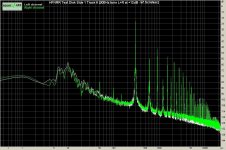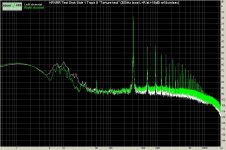"should", but you knew that
Given an "average" system, what would be the audible symptoms of low overload margin and poor recovery time in a phono stage? What does it sound like?
SY may already sharpen his pencil for a relevant article
From my experience with frequent overloading on mediocre o.m. preams, the mid-treble turn harsh and the bass gets ‘bottomed’. (*)
An easy way to experiment is to build an one - i.c. RIAA pre, which you power from a variable PSU. Lowering the DC power, the o.m. of the pre will decrease.
George
(*)But the recovery time and it’s perceived effect vary a lot with amplification stage design, number of stages and f.b. scheme around them.
dvv,
Just cook it well and I am with you on some nice BBQ. Bacon is always welcome but don't think I am eating any of it raw!
Then you should visit Serbia sometime. National pastime is grilling this or that, and cooking in general. Paradise for good food affictionados, although in the words of Hay Hunt III, wife's colleague from New Orleans: "My cholesterol levels will never be the same!", in between two munches of kaymak (local speciality, milk skimming cream).
In case that one has to choose one for the other ?
But one doesn't.
Subsonics are much less of an issue than HF- although gain is high, the velocities are low. When a stage has poor overload, a transient overload event will cause temporary and changing overbias, and you hear a distinctive "choking" sound.
Does it mean that Parasound JC-3, which is split eq.and 15V, has bad overload margin? What about rave reviews it got?
I cannot comment on the sound of the JC3 - I have not heard it.
What I would like to see however is a plot of overload vs frequency. You can normaly tell straight away what type of EQ topology is being used.
A single stage EQ a la Lipshitz for opamp based designs offers the best OLM and with a decent front end the noise is very respectable (see Denis Colin's AXP design).
Designs that try to get lower noise by placing the 2120 pole in the second stage typically sacrifice up to 20 dB in OLM - they score on noise of course because the high gain front end noise is attenuated in the second stage. Others put the 2120 EQ in the first stage and the LF EQ in the second stage - here you can get noise problems if not careful. And the LF overload is much lower than HF OL.
Many tradeoffs . . .
But, good overload and fast recovery are indeed important design goals in my book.
Paradise for good food affictionados
Average life expectancy figures for Serbia seem to contradict that.
Statistics would suggest you have a decade left before you kick the bucket, your eating habbits say less.
You will have to trawl through Stereophile reviews to find it.
If you are using a single stage EQ normally not a proplem. If your 2120 Hz is in the 2nd stage you could overload the front end - in those designs, then typically run the gain quite low to avoid this. But the penalty is higher noise from the 2 nd stage.
If you are using a single stage EQ normally not a proplem. If your 2120 Hz is in the 2nd stage you could overload the front end - in those designs, then typically run the gain quite low to avoid this. But the penalty is higher noise from the 2 nd stage.
Subsonics
SY, in the majority of playback setups, preamplifier overload due solely to subsonic signals is not an issue.
It can be, in combination with a powerful signal of acoustic freq, as the subsonic signal ‘eats-up’ the headroom on the preamplifier that is needed for flawlessly processing the acoustic freq signal .
Below 50Hz the RIAA recording equalization is that of ‘Constant Velocity’, which means that the lowest frequencies, are recorded with comparatively large amplitudes (>Edit: Yes, I understand that your point to the velocity law of the electromagnetic cartridge )
George
It would be nice if Jan could put up in his site the work of Gary Galo on Disk equalization
Last edited:
The LF stuff is more of an issue with the cartridge- the amplitudes can be high (though the voltage output won't be because of velocity), which drives the motor system into a more nonlinear area. The modulation of distortion can't be fixed by the preamp, nor is it (usually) the preamp's fault.
The LF stuff is more
I agree.
As I don’t want cake, I realise that I have caused some confusion or misunderstanding with my previous post. My apologies.
The effect from the majority of subsonic electrical signal (i.e. the 0.55Hz once per revolution wrap-eccentricity signal and the 8-15Hz signal that is produced by the cartridge due to arm/cart resonance) is not accentuated due to the Constant Velocity part of the RIAA recording equalisation, as these signals are not cut into the groove.
Thus, they are also not reduced in amplitude during replay due to the Constant Velocity part of the RIAA playback equalisation (flat part of the curve).
It is all the other sub sonic ‘noise’ recorded into the groove that is accentuated due to the Constant Velocity part of the RIAA recording equalisation
George
Last edited:
But one doesn't.
Subsonics are much less of an issue than HF- although gain is high, the velocities are low. When a stage has poor overload, a transient overload event will cause temporary and changing overbias, and you hear a distinctive "choking" sound.
Without questioning your comment above, to the best of my recollection, I've never heard that kind of effect. Or, if I did, it was so minor as not to be recognized as something wrong, possibly a blurring, or some such.
Average life expectancy figures for Serbia seem to contradict that.
Statistics would suggest you have a decade left before you kick the bucket, your eating habbits say less.
Exactly what do you know of my eating habits?
Just because there's that out there, and is probably traditional, doesn't mean I use food like that on a daily basis.
Statistics generally show averages, and my family tradition is going above those averages by at least 12 years per person.
The only food I am a glutton for and which I depend on almost as a junkie depends on his drugs are tomatoes. It is rich with potassium, and by heritage my body chemistry lacks it - my dad was just the same. I cannot imagine a day, winter or summer, without tomatoes. In fact, all I need for a great meal are some fresh tomatoes and some freshly baked bread - yoghurt I always have a stock of.
Given the degraded condition of my legs, even if it's improving, is that these days I chase women only downhill, I don't gamble, I don't drink anything harder than a beer and that every now and then, by personal choice my diet consists mostly of milk and dairy products and fried meat. And yes, my Brasillian cigarillos a la Clint Eastwood in his "Man With No Name" Italian western days. He had a cheroot, I have cigarillos.
True, I was overweight by some 28 kilos (app. 62 lbs) early on in the year, but yesterday's weighing shows I'm now down by 14 kilos (app. 31 lbs), or about one half of what I should lose. I reckon to get there, down to 90 kilos (or 198 lbs) by the end of this year. And when I put my mind to something, I will do it.
All told, I think I stand a good chance of keeping in line with the family tradition at beating 82. We'll see how you do.
Last edited:
I agree.
As I don’t want cake, I realise that I have caused some confusion or misunderstanding with my previous post. My apologies.
The effect from the majority of subsonic electrical signal (i.e. the 0.55Hz once per revolution wrap-eccentricity signal and the 8-15Hz signal that is produced by the cartridge due to arm/cart resonance) is not accentuated due to the Constant Velocity part of the RIAA recording equalisation, as these signals are not cut into the groove.
Thus, they are also not reduced in amplitude during replay due to the Constant Velocity part of the RIAA playback equalisation (flat part of the curve).
It is all the other sub sonic ‘noise’ recorded into the groove that is accentuated due to the Constant Velocity part of the RIAA recording equalisation
George
Thanks for the clarification ...
Exactly what do you know of my eating habits?
Just because there's that out there, and is probably traditional, doesn't mean I use food like that on a daily basis.
Statistics generally show averages, and my family tradition is going above those averages by at least 12 years per person.
The only food I am a glutton for and which I depend on almost as a junkie depends on his drugs are tomatoes. It is rich with potassium, and by heritage my body chemistry lacks it - my dad was just the same. I cannot imagine a day, winter or summer, without tomatoes. In fact, all I need for a great meal are some fresh tomatoes and some freshly baked bread - yoghurt I always have a stock of.
Given the degraded condition of my legs, even if it's improving, is that these days I chase women only downhill, I don't gamble, I don't drink anything harder than a beer and that every now and then, by personal choice my diet consists mostly of milk and dairy products and fried meat. And yes, my Brasillian cigarillos a la Clint Eastwood in his "Man With No Name" Italian western days. He had a cheroot, I have cigarillos.
True, I was overweight by some 28 kilos (app. 62 lbs) early on in the year, but yesterday's weighing shows I'm now down by 14 kilos (app. 31 lbs), or about one half of what I should lose. I reckon to get there, down to 90 kilos (or 198 lbs) by the end of this year. And when I put my mind to something, I will do it.
All told, I think I stand a good chance of keeping in line with the family tradition at beating 82. We'll see how you do.
Dutchie is 116 , runs uphill and has 3 wives , Dos equis by choice ...

LF over tics and pops .... Find that hard to believe ....
No. It’s Tics and pops (and high modulation velocity signal) over LF
And you are not asked to believe.
Just test it with your system.
With my system, here is what I can show you.
There is some 20-27dB of subsonic signal that the pre had processed in addition to the intended sonic signal (and still not overloading
George
Attachments
There is some 20-27dB of subsonic signal that the pre had processed in addition to the intended sonic signal (and still not overloading).
You wouldn't expect it to overload. The biggest subsonic peak is at the arm-cartridge resonance (~10Hz). That's about 40dB down from the reference, which is +12dB from nominal (in the left figure). So the LF cartridge signal is -28dB from nominal.
Let's plug in an MM with a 5mV nominal output. Assume that the MM preamp has a normal gain structure with 50dB of gain at 1kHz. At 20 Hz, gain will be about 70dB. The LF signal is roughly 0.2-0.3mV, corresponding to about 0.6V out from the preamp. Not very challenging!
- Status
- Not open for further replies.
- Home
- Member Areas
- The Lounge
- John Curl's Blowtorch preamplifier part II

